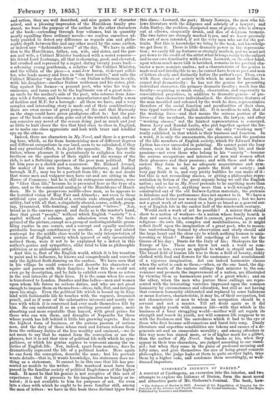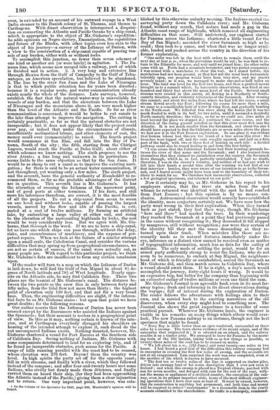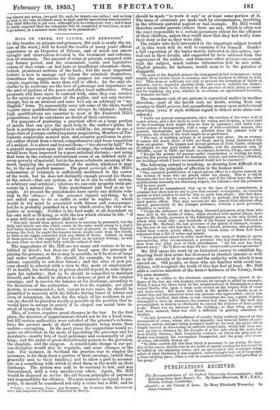GISBORNE'S I5TI1111/81 OF DARIEN. * A so.rouns at Carthagena, an excursion
into the interior, and two attempts to explore the Isthmus of Darien, form the most novel and attractive parts of Mr. Gisborne's Journal. The book, how-
• The Isthmus of Darien in 1852. Journal of the Expedition of Inquiry for the Junction of the Atlantic and Pacific Oceans. By Lionel Gisborne. With four Maps. Published by Saunders and Stanford.
ever, is extended by an account of his outward voyage in a West India steamer to the Danish colony of St. Thomas, and thence to Carthagena. With direct observation is interspersed a disquisi- tion on connecting the Atlantic and Pacific Oceans by a ship-canal, which is appropriate to the object of Mr. Gisborne's expedition : he adds opinions on Negro slavery, Emancipation, the capabilities and future of the Blacks, with other topics even less akin to the object of his journey—a survey of the Isthmus of Darien, with a view to the construction of a ship-canal capable of passing ves- sels of any burden, either with or without locks.
To accomplish this junction, no fewer than seven schemes of one kind or another are (or were lately) in agitation. 1. The Pa- nama line, which seems now merged into a railway, part of which is finished and in action. 2. A very long and extensive line through Mexico from the Gulf of Campeehy to the Gulf of Tehu- antepec, an American speculation, but believed to be abandoned. 3. The line by the river San Juan and the Lake of Nicaragua is that to which public attention has for years been directed ; because it is a regular route, and water communication already exists nearly the whole of the distance. Late surveys, however, establish the fact that the natural water-way is unavailable for vessels of any burden, and that the elevations between the Lake of Nicaragua and the mountains above it, are very much higher than the level of the Atlantic and the Pacific. So far as river communication is concerned, it would be better to cut canals to the lake than attempt to improve the navigation. The cutting is certainly practicable, so far as that the natural obstacles are not insuperable; but it does not appear likely that the project could ever pay, or indeed that under the circumstances of climate, insufficiently acclimatized labour, and other elements of cost, the money could ever (commercially) be raised. The fourth project would commence at San Bias, and fall into the Bay of Pa- nama, South of the city ; the fifth, starting from the Chirigui Lagoon, would reach the Pacific at Dolce Gulf; about either of which schemes we know nothing. The sixth proposes to use the river Atrato ; a line long and unknown in its particulars. It seems liable to the same objection as that by the San Juan. It would be as cheap to cut a canal as to improve the existing navi- gation ; for there is said to be an actual water communication, if not throughout, yet wanting only a few miles. The sixth project, and the seventh, have the general authority of Humboldt-f- to re- commend them, so far as the probable advantages of the district are in question. This seventh line is Mr. Gisborne's. It has the attraction of crossing the Isthmus at the narrowest point, and of good ports at either terminus. If his facts, and still more his inferences therefrom, are correct, it is the most feasible of all the projects. To cut a ship-canal from ocean to ocean on one level and without locks, capable of passing the largest vessels, moved by the flow and ebb of the Pacific, is esti- mated at a cost of twelve millions. By forming an artificial lake, by embanking a large valley at either end, and rising to the elevation of the surrounding highlands by locks, the cost would be very considerably less. But we agree with Mr. Gis- borne, that thorough is the word. If we are to have a ship-canal, let us have one which ships can pass through, without the delay, risks, and encumbrances of machinery, and the expense of per- petual repairs. When we look at the failure of a similar attempt upon a small scale, the Caledonian Canal, and consider the various difficulties that may spring up from geographical circumstances, we are not so certain of success, if the canal were actually cut, as many people are. With regard to this particular project, we think Mr. Gisborne's data are insufficient to form any certain conclusion upon.
If the reader will turn to a map on which the Isthmus of Darien is laid down, he will find the Gulf of San Miguel in about 81 de- grees of North latitude and 781 of West longitude. Nearly oppo- site on the Atlantic side, he may find Calidonia Bay. These two places are the termini of Mr. Gisborne's canal. The distance be- tween the two points as the crow flies is only between forty and fifty miles, from the tidal flow not more than thirty; the highest point of elevation only 130 feet, and that not for a very broad base. Thus, the engineering difficulties are slight, if the inferen- tial facts be as Mr. Gisborne states : but upon that point we have great doubts ; for the following reasons.
Our author asserts that the Isthmus of Darien has never been crossed except by the Buccaneers who assisted the Indians against the Spaniards; but their account is useless in a geographical point a -view. Be this as it may, nothing certain is known of the inte- rior, and at Carthagena everybody shrugged his shoulders on hearing of the intended attempt to explore it, such dread do the yet unconquered Indians excite. Nothing daunted, however, Mr. flisborne Chartered a vessel for Port Escoces at the Southern side of Calidonia Bay. Seeing nothing of Indians, Mr. Gisborne with some companions determined to land for an exploring trip, and if he found no insuperable obstacles, push across for the Pacific. A range of hills running parallel with the coast had to be crossed, whose elevation was 276 feet. Beyond them the country was level. In high spirits the party set off for the opposite coast; fell in with streams, and finally with a river, which they followed instead of the compass; and after four-and-twenty hours met some Indians, who civilly but firmly made them detenues, and finally carried them on board their ship, (for they had been approaching the Atlantic instead of the Pacific,) giving them a clear injunction not to return. One very important point, however, was eats- the volume of the Bpectator for 1849, page 949, Humboldt's opinion will be
found.
Wished by this otherwise unlucky meeting. The Indians cal ried the surveying party down the Calidonia river ; and. Mr. Gisborne found, without any search, that nature had made a gap in the Atlantic coast range of highlands, which removed all engineering difficulties on that score. Still undeterred, our engineer started for Panama across the Isthmus; chartered a little vessel for the Bay of San Miguel ; ascended the river Savannah as high as ho could ; then took to a canoe, and when that was no longer avail- able, landed and pushed across the country in the direction of his former exploration.
" One sailor was left in the boat with orders to remain there until the next day at four p. m., when the provisions would be out ; he was then to re- turn to the Etincelle for more, and wait until we joined him; the other sailor came with us. Porde had a mountain barometer, and two pocket compasses; I was armed with a matchetoe to clear the way. As I stated before, the matchetoea had not been ground, so that had not the wood been fortunately tolerably open, our progress would have been very slow, and my sinews severely taxed; as it was, we managed to make one-and-a-half miles an hour. The land was level for the first two hours, and then a gradual ascent brought us to a summit which, by barometric observations, was fixed at one hundred and thirty feet above the mean level of the Pacific. Several small streams were crossed in this ascent, all flowing in a Southerly or South- easterly direction and evidently tributaries of the Savannah. After crossing this summit, and about five miles from where we had left the canoe, a small stream flowed nearly due East ; following its course for more than a mile, we came to a considerable body of water flowing East, and gradually bending to the North-east. We followed this river along the banks (for it was too much flooded to walk in its bed) for two miles, until it assumed a decidedly North-easterly direction; the valley, as far as we could see, (two miles at least beyond the place we stopped at,) continued the same course, and the direction of the rising ground satisfied us that this river must flow into the Atlantic. It is not much smaller than the Savannah, and about the size I should have expected to find the Calidonia six or seven miles above the place we first saw it in the Port Ricans exploration. In one place it was evident that human labour had thrown the trunk of a tree across this river: the branches were lopped off, and the ends roughly squared, and laid on a firm part of the bank, with two or three feet of bearing on each side : a decided pathway could also be traced leading to and from this foot-bridge. "I was aware that the Calidonian Indians had their hunting-grounds be- tween the river of that name and the Savannah ; and I also learned from themselves that they claimed no jurisdiction over the country the Savannah flows through, which is, in fact, perfectly uninhabited. I had no doubt, therefore, I was in the enemy's country, and neither of us had any wish to fall into their hands a second time after the warning we had had at our first interview : besides, they were aware of our intention to go to the Savan- nah, and I feared scouts might have been sent to the boundary of their ter- ritory to watch for us. We therefore took barometric observations, collected a few geological specimens, and returned on our path."
Now it certainly may be, as Mr. Gisborne in his report to his employers states, that the river six miles from the spot whence he returned was identical with the spot he had reached from Port Escoces : but this opinion is by no means con- clusive. Astronomical observation would scarcely have established the identity, mere conjecture certainly not. We have seen how the party went wrong in their first exploration. When they turned back as just stated, they lost their way, though Mr. Gisborne " here and there" had marked the trees. In their wanderings they reached the Savannah at a point they had previously passed in the canoe without recognizing it; they descended it till stopped by mangroves, still without recognition; nor were they certain of the identity till they met the canoe descending as they re- turned upon their track. When mistakes like these are ne- cessarily made as to natural features immediately under the eye, inference on a distant view cannot be received even as matter of topographical information, much less as data for the outlay of millions. The only mode of settling the point, would be for an armed party sufficiently strong to resist the Indians, who do not seem to be numerous, to embark at San Miguel, the neighbour- hood of which is friendly or uninhabited, ascend the Savannah as Mr. Gisborne did, and then march across to Calidonia Bay, where a vessel should await them. If he is right, a day's march would accomplish the journey, forty-eight hours if wrong. It would be an expensive trip, but better for the company than beginning with an estimated outlay of twelve millions or even one third the sum.
Mr. Gisborne's Journal is an agreeable book even in its most far- away topics ; fresh and informing in its direct observations during the voyage ; full of interest during the exploration of Darien. The reader follows the adventurers with feelings akin to their own, and is carried back to the exciting narratives of the old discoverers, when every step might lead to something new. The Journal also shows the great importance to a traveller of some practical pursuit. Wherever Mr. Gisborne lands, the engineer is visible in his remarks on many things which others would over- look. The new Panama railway is an instance, though not the best specimen that might be found.
"Navy Bay is little better than an open roadstead, surrounded on three sides by a swamp. The town shows evidence of its recent origin, and of the enterprise that originated it ; it is situated on an island, and the railway reaches it on a timber jetty. We arranged to leave for Panama by the morn- ing train of the 23d instant, taking with us as few things as possible, as twenty-three miles of the road has to be crossed on mules. "We left about ten a. m., (23d June,) and went twenty-one miles in two hours. I had heard a good deal of the difficulties this railway company had to encounter in crossing the first few miles of swamp, and the accounts are not at all exaggerated. lam surprised the work was ever completed, even at the sacrifice of life which is known to have occurred.
"The first ten or twelve miles of the line is supported on timber piles, driven into swampy land of far worse description than I ever saw even in Ireland ; and when this swamp is placed in a 'Tropical climate, parched with sun for seven months, and deluged with rain for the rest of the year, with- out the means or appliances of a civilized country, the execution of the rail- way, even in its present imperfect state, is one of the most difficult engineer- ing operations that I have ever seen or read of. It must be owned, however, that its construction is anything but permanent, and both time and money will be required to reduce 'maintenance' to a reasonable item in the yearly accounts submitted to the shareholders. Its traffic is a monopoly, command- jog almost any prices, (we paid 32s. each for twenty-one miles,) and as long as such is the case dividends must be high and the speculation remunerative. The chief difficulty is got over, although only in a temporary way ; and it may be fairly expected that the remainder will be completed in two years, or per- haps sooner, in a manner more likely to be permanent."




























 Previous page
Previous page